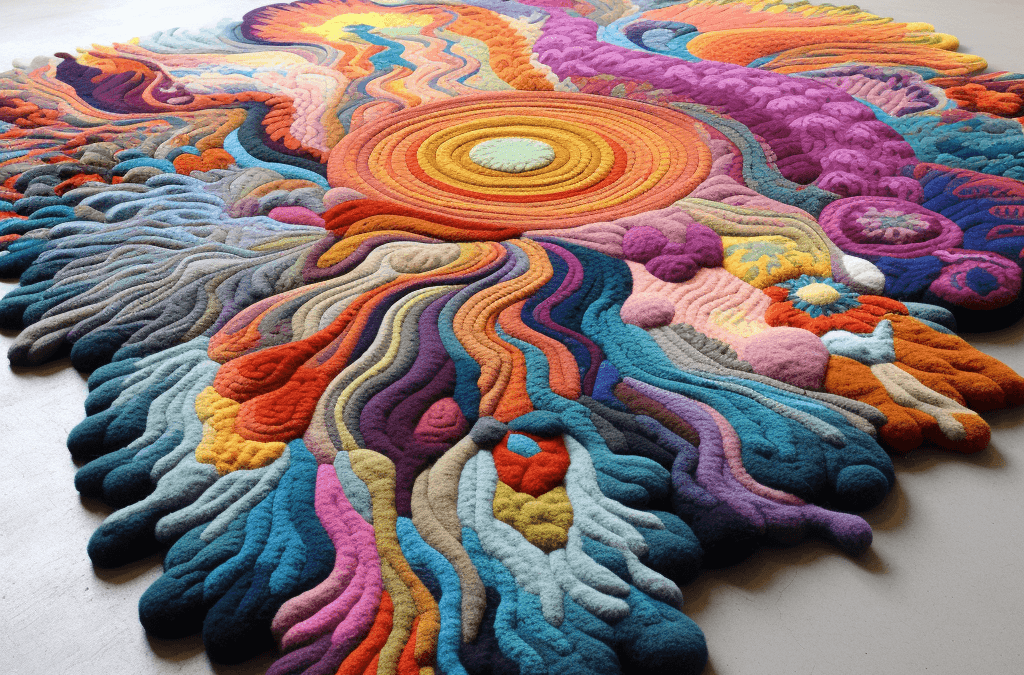A floor rug is a popular addition to a hard surface floor such as tile, laminate, or hardwood. It can even be placed over wall-to-wall carpet. There are many reasons why floor rugs are so popular, yet some people may be doubtful whether they should cover up their floors with a rug or not.
Perhaps the most prominent reason to own a floor rug is for the look of it. Floor rugs have a different way of bringing together all of a room’s elements—for instance, they can pull together diverse colors used in the décor.
But the advantages of floor rugs extend far beyond decor. They can improve the indoor air quality but require proper cleaning and care – something we will discuss next.
Get Expert Recommendations on How to Clean Your Floor Rug
While you need to vacuum the carpet twice a week, you only need to deep-clean your floor rug when it’s dirty. If the rug isn’t visibly soiled (or noticeably foul-smelling), try this test: pick up one corner of the rug and let it drop down onto the floor. If you see a tiny cloud of dust rising up after the impact, it’s time to clean the rug.
Although you can outsource your rug cleaning to a cleaning company for the best results, you can do it yourself if you have the right materials and ample free time.
You’ll have the peace of mind knowing precisely the type of cleaners that are being applied on your rug—a piece of information that’s important to many, particularly those with young children or susceptible to chemical sensitivities.
Read the further sections to know how to clean your floor rug in a simple yet effective way.
Basic floor Rug Care
The material, size, and construction of the rug determine the optimum way to clean it. Ideally, floor rugs require more intensive care than a wall-to-wall carpet. But if done right, most rugs will benefit from the following care routine:
1. Vacuum large floor rugs to remove dirt
Vacuuming is one of the most effective ways of cleaning a floor rug. If your rug is reversible, you can vacuum it on both sides. This removes grime and grit that can damage your rug prematurely. Make sure you do not vacuum any fringe.
2. Brush out pet hair
While using a vacuum, chances are it will leave the pet hair behind. Use a hard-bristle brush to get rid of the hair, brushing along the direction of the rug’s hair.
3. Turn rugs every year
Sun and foot traffic can put additional stress on your floor rug. Experts advise turning your rug once or twice a year to counter the wear.
4. Shake small floor rugs
If you own a small rug, you can take it outside and shake it to get rid of the dirt and debris. You can also beat it gently with a stick to discharge the grit and dirt. Note that some areas have laws about shaking rugs outdoors, so check that first before doing this activity.
Remove Stains from Rugs
Time is of the utmost importance when your rug gets stained. Make sure to blot (not rub) the stain and remove the moisture caused by the spills as soon as possible.
1. Alcohol and soft drinks
Use this mixture: One quart of warm water, one teaspoon liquid dish detergent, and one-fourth teaspoon of white vinegar. Apply to the stain-affected area and rinse. Once you blot dry, the stain should be gone.
2. Coffee or Tea
Using the solution you prepared above, apply to tea or coffee stain. Then rinse and blot. If the stain persists, you can use a commercial spot cleaner (if you have or can rent one). If the stain still won’t come off, call experts to clean stains from rug.
3. Fat-based stains
You can use any dry-solvent spot cleaner for margarine, butter, or gravy based stains.
4. Paint
For latex and acrylic paints, do spot-cleaning with the detergent while the stain is still moist. If the stain persists, use alcohol to dab the affected area. For oil-based paints, use odourless mineral spirits to sponge the stained area. Make sure you do not soak through the backing.
5. Tomato Sauce
Sponge the stained area with cool water and dab it with either a citrus-oxygen cleaner or a detergent solution. Rinse with a mixture of 2 cups of water and a cup white vinegar and blot the area till the fibers dry.
6. Urine, Vomit, and Feces
Use a detergent solution or a citrus-oxygen cleaner on the stain. Rinse and blot thoroughly until it dries.
Deep-Clean Floor Rugs
Check for care labels for small rugs to decide whether they should be laundered, spot-cleaned, or dry-cleaned. A dry-cleaning-only label might mean that the rug in question is not colourfast. Always test before spot-cleaning. When you establish that the rug is colourfast, machine-wash it on the delicate cycle.
To decrease the risk of tangling the long fringe, divide it into several hanks and wrap each one with white string. Store the rug in a zippered pillowcase or a mesh laundry bag to shield it from the agitator and wash it in cold water on the gentle cycle.
Droop your wet rug over a slatted picnic table, clothes-drying rack, or many bricks stacked on a breezeway, porch, or patio. Dangling your wet rug over a single clothesline will deform the shape of the rug as it dries.
Miniature rugs made from synthetic fibers can be placed to dry on a little work table or a counter shielded by a drop fabric, towels, or old sheets.
Your floor rug will benefit from deep cleaning every twelve to eighteen months. If you’re using commercial cleaning products for the first time, it’s advisable to test a small portion of the rug to ensure that it is colourfast and won’t be damaged by the product.
To completely clean a large rug, place it on a concrete or vinyl surface, apply the cleaning foam and rub in the same direction. Conclude the process by vacuuming or rinsing. Also, ensure that the rug is dry before replacing it.
Dry-cleaning can also be a good option for small-to-mid-size rugs—however, always check the labels for care instructions.
Can you wash a floor rug?
If you own a small-sized rug, it can be put into your washing machine. Use a cold setting on a gentle cycle, and allow it to air-dry for some time.
However, if your rug is too large to fit inside the machine, you can send it out to be washed in a commercial cleaning pit.
If you are going to do it yourself, here’s what you will need:
- Vacuum
- Broom
- Carpet Shampoo/liquid dish soap
- Tarp
- Laundry drying rack
- Hose
- Soft-bristle brush
- Towels
Step 1: Vacuum
Vacuum the rug’s top, then flip it over and repeat the same process for its back. Many people ignore the rug’s back, but the truth is, the rug’s back collects dirt and dust equally.
Step 2: Take It Outside
Once outdoor, unroll it and prop it up on the porch railing or fence. Whack the rug’s back using a broom to check if more dirt comes out. If you see the dirt clouds rise, keep beating the rug until the dirt clouds aren’t visible anymore.
Note: If your rug’s back has latex material, do not beat it too hard, lest the latex gets damaged.
Step 3: Rinse Your Rug
Place your rug on a deck or tarp, but ensure it is near a water supply, say, the garden hose. Follow the label-directions of your rug. If you don’t wish to use cleaning shampoo, you can use a bucket and prepare your own mix of warm water and a tablespoon of mild, liquid dish soap.
Before cleaning floor rugs, first, spot-test the solution in a small portion of the rug to ensure that the colours don’t bleed.
If the colours still bleed, take the rug to a professional cleaner. If you don’t notice any colour bleed, rinse the rug using the machine’s hose. Pour the soap mixture into a soft and sturdy brush and work it into the rug. Allow the rug to sit for a few minutes before rinsing it off.
Step 4: Dry It Off
Use a towel to absorb as much excess water as possible. Let it air-dry outdoors on a laundry drying rack. This may take more than twenty hours. If air-drying the rug outdoors isn’t possible for long, take it to your basement, laundry area, or garage to continue the drying process.
Step 5: Repeated Vacuuming
Put the rug back to where it belongs, and repeat the vacuum process.
How do you clean an area rug without a shampooer?
The cleaning products and chemicals used to deep clean a rug can usually be too strong for people who have sensitivities to certain elements. If you want to avoid harsh chemicals, try the below methods:
Vinegar, Dish Soap and Water
Mix one-quarter of lukewarm water with one tablespoon of dish soap. Add one-fourth teaspoon of white vinegar to the mix. You will get a good overall cleaner. Make sure to test the solution on a tiny, inconspicuous spot on your rug before applying it to the stain affected area.
Club Soda
Club soda works as an effective cleaner when it is spritzed on the rug. It works well for eliminating wine and bloodstains. Apply a little amount of soda on the stain, then using a dry cloth or paper towel, blot the area until the stain is gone. Instead of scrubbing, rub the rug’s fibres.
Bonus Tip
Another effective method of washing the rug is using a mixture of liquid soap and a few drops of lukewarm water. This soap is fitting because it is non-toxic, yet it is sturdy enough to remove dirt and other debris.
Using a clean fabric, scrub the rug with the solution, and blot the surface using a dry towel to eliminate up as much water as possible.
Conclusion
Floor rug cleaning isn’t rocket science. In most cases, it doesn’t require help from professional cleaning companies either. This article contains expert tips on how to clean your floor rug effectively, by yourself. We hope these expert-tips will help you to clean and maintain your rug to ensure its longevity.










